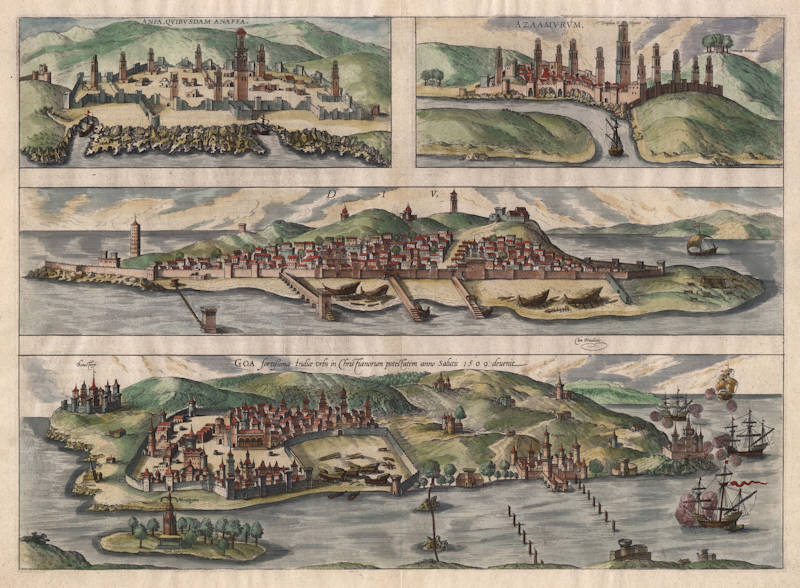Leen Helmink Antique Maps & Atlases
www.helmink.com
Braun and Hogenberg
Anfa/Azaamurum/Diu/Goa
Certificate of Authentication and Description
This is to certify that the item illustrated and described below is a genuine antique
map, print or book that was first produced and published in 1572, today 453 years ago.
December 15, 2025
Cartographer(s)
Braun and Hogenberg
First Published
Cologne, 1572
This edition
Size
33.6 x 46.8 cms
Technique
Copper engraving
Stock number
18792
Condition
mint


Description
The earliest obtainable printed views of Goa and Diu, the two major Portuguese strongholds in India. Goa was also the seat of the Portuguese Viceroy and the Bishop for Portuguese India and the Portuguese Indies.
Two smaller views of Anfa and Azimur in Africa have been included at the top of the print.
The four city views include many detailed depictions of Portuguese and Arab sailing ships from the age of exploration.
Braun and Hogenberg's Civitates Orbis Terrarum was the first and best town atlas with city views from around the world.
It was an extensive work, issued in six volumes from 1572 to 1617. Of the more than five hundred sheets with city views, only five Braun & Hogenberg sheets offered the European audience a first view of cities outside Europe and the Mediterranean: four from the Portuguese strongholds in Africa, Arabia and Asia, and one of the Americas. This makes these views of highest significance to the early voyages of discovery.
Condition
Early dark and even imprints of the copperplate. No restorations or imperfections. Pristine condition, which is of utmost rarity for Braun & Hogenberg views.
Georg Braun (1541-1622)
Frans Hogenberg (c.1536-1588)
In 1572 Frans Hogenberg, who engraved maps for Ortelius, together with another noted engraver of the time, Georg Hoefnagel, compiled and issued in Cologne a City Atlas intended as a companion work to Ortelius' "Theatrum Orbis Terrarum". Entitled "Civitatis Orbis Terrarum" and edited by Georg Braun, the six volumes of this famous work were issued between the years 1572 and 1618 and contained in all more than 500 city plans and views.
The atlas provides a fascinating sixteenth-century picture of the principal cities and towns in Europe, Asia, Africa and even America and records details of public buildings, heraldic devices and rural and domestic scenes, besides many street names.
Towns are usually shown in bird's-eye view, set in picturesque and romantic backgrounds with figures of inhabitants in local dress placed boldly in the foreground.
Although some of the city views had been included in earlier works like Munster's Cosmographia, in most instances they were the first views to appear in print.
The Braun and Hogenberg plates eventually passed to Jan Jansson who reissued the plans in Amsterdam in 1657, having removed the costumed figures which, of course, by this time were no longer of contemporary interest.
(Moreland and Bannister)